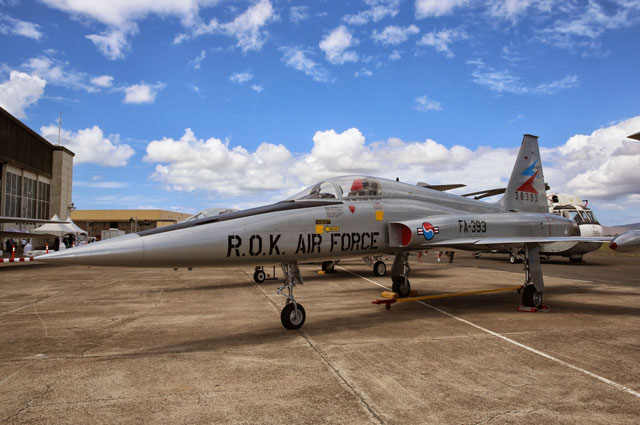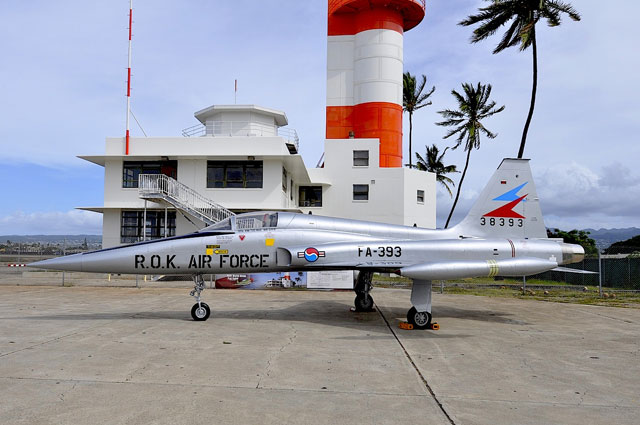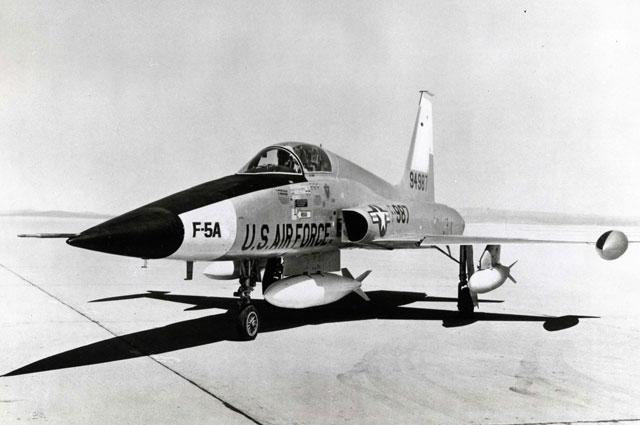
Northrop F-5A Freedom Fighter
Snapshot
- Nickname:
- Tiger
- Number Built:
- 636
- Make:
- Northrop
- Mission:
- Fighter
- Location:
- ハンガー79
Background
It’s been a dilemma since the dawn of aerial combat — tiny, nimble and simple, or fast, brawny and expensive? In the 1950s, the U.S. Air Force, focused on stopping Soviet bombers, was building squadrons of massive, complicated interceptors. Northrop engineers had a better idea.
How do you make a fighter as small and basic as possible and still fly at supersonic speeds? The answer was a pair of lightweight engines originally designed for missiles. General Electric’s J85 engines weighed less than 500 pounds, yet produced up to 5,000 pounds of thrust. The small size of the engines led to a design that was agile, fast and simple. But the Air Force didn’t want a new fighter; it needed a supersonic trainer. The resulting T-38 Talon is still the Air Force’s primary trainer.
For years, the United States had provided obsolete, surplus aircraft to its allies. During the Cold War, President Kennedy created the Military Assistance Program, with an immediate need for modern aircraft smaller nations could afford.
Privately, Northrop had continued to test their lightweight fighter because of Army interest in a ground-attack aircraft. The F-5A entered service in 1964 and immediately won 85 percent of weapons competitions. The first buyer was the Shah of Iran, and by the time production stopped on the F-5A in 1972, nearly two dozen countries had it in their arsenal.
The first supersonic aircraft tested without accident, the F-5A could carry a load half its weight – the highest ratio of any supersonic fighter – and the fuselage is covered in removable panels for easy maintenance. A crew of three could change an engine in 20 minutes.
The F-5A first entered combat in Vietnam. The “Skoshi Tiger” program provided F-5As to the South Vietnamese Air Force from the United States and on loan from American allies. Within six hours of arriving in Vietnam, the F-5A flew its first mission.The small airplane gained a reputation in Vietnam as a precision bomber. Ironically, F-5As captured by communist forces later engaged in swirling dogfights on the Chinese border.
Our F-5A is one of four acquired by the Imperial Iranian Air Force in 1969. It was likely based at Chan Bahar Air Base, which is primarily underground and charged with the defense of the Strait of Hormuz. Transferred to Jordan in 1974, this F-5A then wound up in the United States.It is painted in Republic of Korea Air Force markings, circa 1965. Korea was one of the first buyers of the F-5A, and the little interceptors were involved in several border incidents – most of which remain classified. This aircraft honors Gen. Kim Too Man, a legendary figure in the ROKAF.
As Northrop’s F-5 enters its sixth decade, the legacy lives on in the F-5E, RF-5E and F-5F editions. The F/A-18 naval fighter-bomber is a direct descendent. After more than 2,600 constructed, the final F-5 was delivered in 1989. Every aircraft was delivered on schedule, at or below the contract price, and with performance as promised.
Today the F-5 is used as an adversary fighter in the “Top Gun” and “Red Flag” combat schools. It still outperforms almost every aircraft in the American inventory.
Please visit “Northrop F-5A Freedom Fighter (And T-38 Talon)” blog post for more information on this aircraft.
Specs
- Contractor
- Northrop
- Deployment Date
- July 30, 1959
- Span
- 26 feet, 8 inches
- Length
- 47 feet, 4.75 inches
- Height
- 13 feet, 4.5 inches
- Weight
- 24,722 lbs
- Max. Speed
- 1,060 MPH
- Service Ceiling
- 50,000+ feet
- Range
- 870 miles
- Crew
- 1 Pilot







